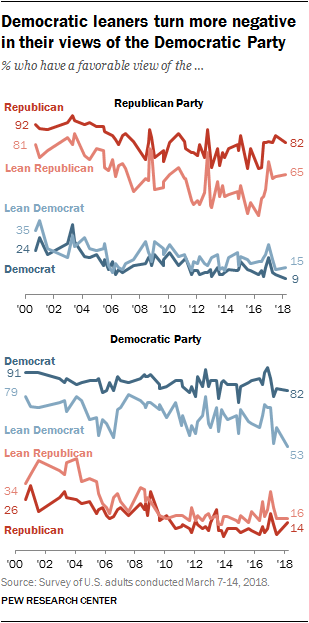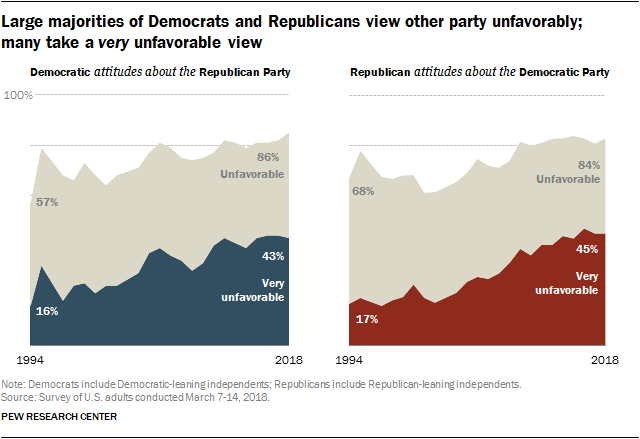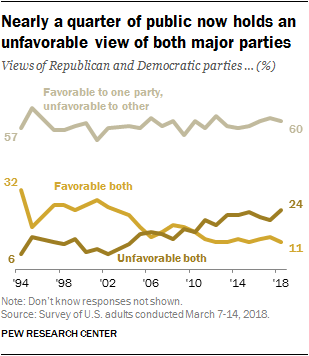
The American public has doubts about Donald Trump’s level of respect for the country’s democratic institutions and traditions. Like all views of Trump, attitudes are deeply partisan; Republicans give the president positive marks in this regard, while Democrats are highly negative.
Overall, 54% say Trump has not too much (25%) or no respect at all (29%) for the nation’s democratic institutions and traditions; somewhat fewer (45%) say he has a great deal (23%) or a fair amount (22%) of respect for them. The share saying Trump has at least a fair amount of respect for the country’s democratic institutions is slightly higher than it was in February 2017, when just 40% took this view.
Republicans and Republican-leaning independents are confident in Trump’s respect for the country’s democratic institutions and traditions: About three-quarters (77%) say he has at least a fair amount of respect for them, including 45% who say he has a great deal of respect. There is a divide among Republicans on this question by ideology. Conservative Republicans (84%) are much more likely than moderates and liberals (64%) to say Trump respects the country’s democratic institutions; and conservative Republicans are about twice as likely as moderate and liberal Republicans to say Trump has a great deal of respect for the country’s democratic system (55% vs. 27%).
Democrats and Democratic leaners are highly critical of Trump’s regard for the nation’s democratic system. Just 16% think he has at least a fair amount of respect for the country’s democratic institutions and traditions; 51% say he has none at all, and another 32% say he has not too much. There also are ideological differences among Democrats on this question; liberals (60%) are more likely than moderates and conservatives (43%) to say Trump has no respect at all for the country’s democratic institutions and traditions.
Public sees risks in granting greater presidential powers

A large majority of Americans say it’s important for there to be a balance of power between the three branches of the federal government. Consistent with this view, most oppose the idea of strengthening the power of the executive branch. Just 21% say that many of the country’s problems could be dealt with more effectively if the president didn’t have to worry so much about Congress or the courts. About three-quarters (76%) say that it would be too risky to give U.S. presidents more power to deal directly with the country’s problems.
Public opposition to strengthening the powers of the presidency has held steady over the past few years. In two previous surveys – conducted in August 2016, during Barack Obama’s final year in office, and in February 2017 – similar shares of the public said it would be too risky to give U.S. presidents more power.

Most Republicans and Democrats oppose expanding the powers of the presidency. However, in the current survey, opposition to this is somewhat higher among Democrats and Democratic leaners (83%) than among Republicans and Republicans leaners (70%). By contrast, in August 2016, when Obama was president, a greater share of Republicans (82%) than Democrats (66%) opposed granting the president expanded powers at the expense of Congress and the courts.

On the whole, younger adults are more cautious about expanding executive power than older adults.
Among those ages 18 to 29, 85% say it’s too risky to give presidents more power. By comparison, a smaller majority of those 65 and older say the same (62%).
This age dynamic exists within both parties. While partisans across age cohorts say it would be too risky to give presidents more power to deal directly with the country’s problems, Democrats and Republicans younger than 50 are more likely than their older counterparts to hold this view.
Most say the president has large impact on U.S. standing, national mood

Most Americans say the president has a big impact in areas such as national security and U.S. standing in the world, but relatively few say the occupant of the executive office makes a big difference in their personal lives.
Overall, 69% say that who is president makes a big difference on the standing of the U.S. in the world; most also say the president makes a big difference for the mood of the country (63%) and national security (61%). About half (53%) say that who is president makes a big difference for the economy.
By contrast, far fewer (34%) think who is president makes a big difference in their own personal lives; 39% say it makes some difference and a quarter say it makes no difference.

Women are more likely than men to say who is president makes a big difference in their own personal lives. Four-in-ten women say this compared with about three-in-ten men (29%).
Young adults ages 18 to 29 are less likely than older adults to say that who is president makes a big difference for their own personal life. Just 24% of those 18 to 29 say this, compared with 34% of those ages 30 to 49, 37% of those 50 to 64 and 44% of those 65 and older.
Favorability ratings of the Republican and Democratic parties

On balance, the public offers negative ratings of both the Republican and Democratic parties. By 55%-41% more take an unfavorable than favorable view of the Republican Party. Views of the Democratic Party are similar: 54% have an unfavorable view, compared with 42% who rate the party favorably.
Ratings of the Republican Party are now higher than they were for much of 2015 and 2016, prior to the election of Donald Trump. However, they are down from a recent high of 47% in January 2017, immediately after the election.
By contrast, views of the Democratic Party are about as low or lower than they were at any point during the run-up to the 2016 election. Favorable ratings of the Democratic Party reached 52% in October 2016 and were about that high in January 2017, before declining in the spring of that year.

Declining views of the Democratic Party are tied, in part, to more negative ratings among those who lean toward the Democratic Party but do not identify with it.
Overall, 53% of Democratic leaners hold a favorable view of the party, down from 73% who said this in January 2017. The current ratings of the party among Democratic leaners are as low as they have been at any point in Pew Research Center surveys conducted over the past two decades.
By contrast, about two-thirds (65%) of Republican leaners view the GOP favorably. These ratings are down somewhat from a post-election high, but remain far more positive than at most other points over the past several years.
There is no difference between how self-identifying Republicans and Democrats rate their own parties. Overall, 82% of Republicans and the same share of Democrats say they view their respective party favorably.
For the past several decades, members of both parties have expressed predominantly unfavorable views of the opposing party. But the intensity of these attitudes is much higher today than it was 10 or 20 years ago.
Overall, comparable majorities of Democrats and Democratic leaners (86%) and Republicans and Republican leaners (84%) say they hold unfavorable views of the opposing party. Among Republicans, 45% say they hold a very unfavorable view of the Democratic Party; a similar share of Democrats (43%) has a very unfavorable view of the GOP. In 1994, just 17% of Republicans and 16% of Democrats said they viewed the opposite party very unfavorably; and as recently as 2009, only about a third of both groups held intensely negative views of the other political party.

Recent Pew Research Center surveys have found that antipathy toward the other party is a key driver of an individual’s own party identification. Majorities of Republicans and Democrats – as well as Republican and Democratic leaners – cite harm from the opposing party’s policies as a major reason for their own partisan orientation.

With the public holding relatively dim views of both major political parties, almost a quarter (24%) now have unfavorable views of both the Republican and Democratic parties.
The share with unfavorable views of both parties was just 6% back in 1994; it is now as high as it has ever been in Pew Research Center surveys dating to that year.
Just 11% of the public say they have a favorable view of both major parties – down from 32% in 1994.
Most Americans (60%) continue to view one party favorably and the other unfavorably. The share with this combination of views has stayed relatively steady over the past few decades as unfavorable views toward both parties have increased and favorable views of both parties have decreased.
Most of those with unfavorable views of both parties identify as independents (63%); Democratic-leaning independents make up a slightly larger share than Republican-leaning independents. A plurality (41%) describe themselves as moderate; 28% are conservative and 28% say they are liberal. Those who have an unfavorable opinion of both major parties also tend to be relatively young (59% are under age 50).